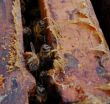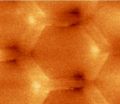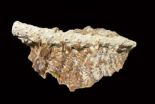(Press-News.org) Research from North Carolina State University shows that honey bees "self-medicate" when their colony is infected with a harmful fungus, bringing in increased amounts of antifungal plant resins to ward off the pathogen.
"The colony is willing to expend the energy and effort of its worker bees to collect these resins," says Dr. Michael Simone-Finstrom, a postdoctoral research scholar in NC State's Department of Entomology and lead author of a paper describing the research. "So, clearly this behavior has evolved because the benefit to the colony exceeds the cost."
Wild honey bees normally line their hives with propolis, a mixture of plant resins and wax that has antifungal and antibacterial properties. Domesticated honey bees also use propolis, to fill in cracks in their hives. However, researchers found that, when faced with a fungal threat, bees bring in significantly more propolis – 45 percent more, on average. The bees also physically removed infected larvae that had been parasitized by the fungus and were being used to create fungal spores.
Researchers know propolis is an effective antifungal agent because they lined some hives with a propolis extract and found that the extract significantly reduced the rate of infection.
And apparently bees can sometimes distinguish harmful fungi from harmless ones, since colonies did not bring in increased amounts of propolis when infected with harmless fungal species. Instead, the colonies relied on physically removing the spores.
However, the self-medicating behavior does have limits. Honey bee colonies infected with pathogenic bacteria did not bring in significantly more propolis – despite the fact that the propolis also has antibacterial properties. "There was a slight increase, but it was not statistically significant," Simone-Finstrom says. "That is something we plan to follow up on."
There may be a lesson here for domestic beekeepers. "Historically, U.S. beekeepers preferred colonies that used less of this resin, because it is sticky and can be difficult to work with," Simone-Finstrom says. "Now we know that this is a characteristic worth promoting, because it seems to offer the bees some natural defense."
INFORMATION:
The paper, "Increased resin collection after parasite challenge: a case of self-medication in honey bees?," was co-authored by Dr. Marla Spivak of the University of Minnesota and is available online from PLoS ONE. The research was funded by the National Science Foundation.
Bees 'self-medicate' when infected with some pathogens
2012-04-02
ELSE PRESS RELEASES FROM THIS DATE:
Extreme weather threatens rich ecosystems
2012-04-02
Extreme weather such as hurricanes, torrential downpours and droughts will become more frequent in pace with global warming. Consequently, this increases the risk for species extinction, especially in bio diverse ecosystems such as coral reefs and tropical rainforests.
Human impact means that flora and fauna become extinct at a rate 100 times higher than normal. Climate change has been deemed as one of the main causes of species depletion.
A research team in theoretical biology at Linköping University in Sweden has, through the use of mathematical modelling and simulation, ...
IOM report identifies public health actions for improving the lives of those with epilepsy
2012-04-02
WASHINGTON — An estimated 2.2 million people in the United States live with epilepsy, a complex brain disorder characterized by sudden and often unpredictable seizures. The highest rate of onset occurs in children and older adults, and it affects people of all ethnicities and socio-economic backgrounds, yet this common disorder is widely misunderstood. Epilepsy refers to a spectrum of disorders with seizures that vary in type, cause, severity, and frequency. Many people do not know the causes of epilepsy or what measures to take if they witness a seizure. A new report ...
Honeycombs of magnets could lead to new type of computer processing
2012-04-02
Scientists have taken an important step forward in developing a new material using nano-sized magnets that could ultimately lead to new types of electronic devices, with greater capacity than is currently feasible, in a study published today in the journal Science.
Many modern data storage devices, like hard disk drives, rely on the ability to manipulate the properties of tiny individual magnetic sections, but their overall design is limited by the way these magnetic 'domains' interact when they are close together.
Now, researchers from Imperial College London have ...
Declines in Caribbean coral reefs pre-date damage resulting from climate change
2012-04-02
The decline of Caribbean coral reefs has been linked to the recent effects of human-induced climate change. However, new research led by scientists at Scripps Institution of Oceanography at UC San Diego suggests an even earlier cause. The bad news – humans are still to blame. The good news – relatively simple policy changes can hinder further coral reef decline.
Employing a novel excavation technique to reconstruct the timeline of historical change in coral reefs located on the Caribbean side of Panama, a team of scientists led by Scripps alumna Katie Cramer and current ...
Published study finds usage of, reccomendations for dietary supplements high among dietitians
2012-04-02
WASHINGTON, D.C. -- Registered dietitians are one of several groups of healthcare professionals who report using dietary supplements as part of their health regimen, according to a newly published study in Nutrition Journal, a peer-reviewed, online journal that focuses on the field of human nutrition. According to data from the 2009 "Life…supplemented" Healthcare Professionals (HCP) Impact Study, 74 percent of dietitians use dietary supplements regularly while 22 percent reported using them occasionally or seasonally. The data also indicated that an overwhelming percentage ...
Amyloid beta in the brain of individuals with Alzheimer's disease
2012-04-02
The deposition of amyloid beta in the brain of individuals with Alzheimer's disease is the focus of much research into both its cause and treatment.
While there may not be a consensus as to whether the deposition contributes to the disease or is a consequence of the disease, there is agreement that it is not favoured thermodynamically, meaning that something else is promoting the process.
Other proteins are often co-deposited in vivo with amyloid beta and one such protein is serum amyloid P component (or SAP). Recent evidence has suggested that SAP is elevated in Alzheimer's ...
Tales from the crypt lead researchers to cancer discovery
2012-04-02
HUNTSVILLE, Ala – Tales from the crypt are supposed to be scary, but new research from Vanderbilt University, the HudsonAlpha Institute for Biotechnology and colleagues shows that crypts can be places of renewal too: intestinal crypts, that is. Intestinal crypts are small areas of the intestine where new cells are formed to continuously renew the digestive tract. By focusing on one protein expressed in our intestines called Lrig1, the researchers have identified a special population of intestinal stem cells that respond to damage and help to prevent cancer.
The research, ...
Newly discovered foot points to a new kid on the hominin block
2012-04-02
It seems that "Lucy" was not the only hominin on the block in northern Africa about 3 million years ago.
A team of researchers that included Johns Hopkins University geologist Naomi Levin has announced the discovery of a partial foot skeleton with characteristics (such as an opposable big toe bone) that don't match those of Lucy, the human ancestor (or hominin) known to inhabit that region and considered by many to be the ancestor of all modern humans.
The discovery is important because it provides first-ever evidence that at least two pre-human ancestors lived between ...
US stockpile security and international monitoring capabilities strengthened, says new report on technical issues behind the comprehensive nuclear test ban treaty
2012-04-02
WASHINGTON — The United States is now in a better position than at any time in the past to maintain a safe and effective nuclear weapons stockpile without testing and to monitor clandestine nuclear testing abroad, says a new report from the National Research Council. The report, requested by the Office of the Vice President and the White House Office of Science and Technology Policy, reviews and updates a 2002 study that examined the technical concerns raised about the Comprehensive Nuclear Test Ban Treaty (CTBT). The report does not take a position on whether the U.S. ...
Planet under Pressure conference, London: Final statement
2012-04-02
Scientists issued the first "State of the Planet" declaration at a major gathering of experts on global environmental and social issues in advance of the major UN Summit Rio+20 in June.
The declaration opens: "Research now demonstrates that the continued functioning of the Earth system as it has supported the well-being of human civilization in recent centuries is at risk." It states that consensus is growing that we have driven the planet into a new epoch, the Anthropocene, where many planetary-scale processes are dominated by human activities. It concludes society ...



